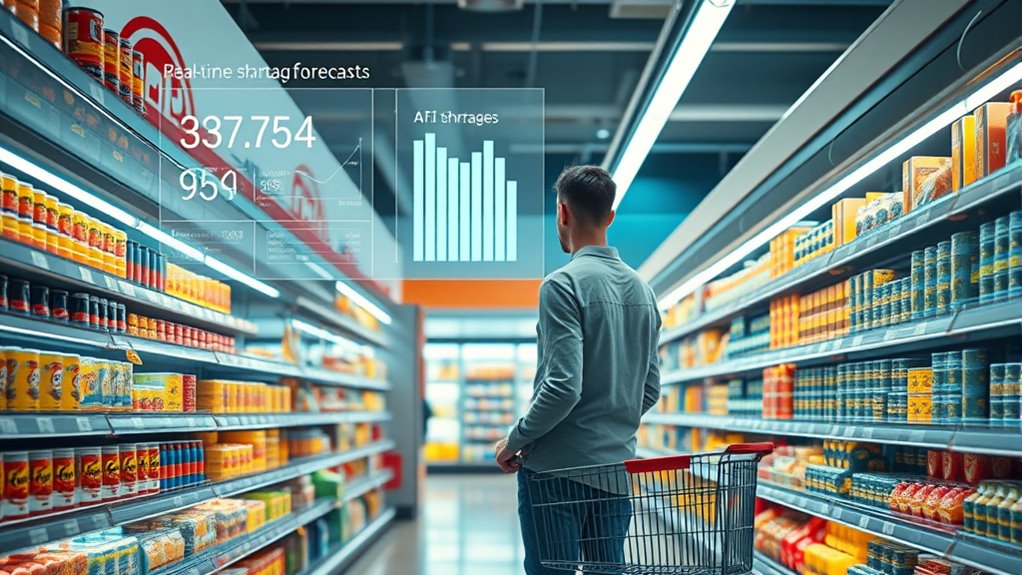AI-driven demand forecasting lets you spot shortages before shelves go empty by analyzing real-time data from sales, weather, social media, and competitors. It predicts demand shifts early, helping you adjust inventory proactively and prevent stockouts. By continuously learning and adapting, AI increases forecast accuracy up to 50%, making your supply chain smarter and more responsive. If you want to discover how this technology can keep your shelves stocked seamlessly, there’s more to explore ahead.
Key Takeaways
- AI analyzes diverse data sources like sales, weather, and social media for early demand signals.
- Machine learning models continuously improve forecast accuracy, predicting shortages before they occur.
- Real-time demand predictions enable proactive inventory adjustments to prevent stockouts.
- Scenario simulations assess potential supply disruptions, allowing preemptive contingency planning.
- Integration with inventory systems facilitates immediate replenishment, reducing shelf shortages proactively.

Artificial intelligence is revolutionizing how retailers manage supply chains by predicting shortages before shelves go empty. With AI-driven demand forecasting, you can reduce supply chain errors by 20 to 50%, helping you avoid costly stockouts. By analyzing multiple data sources—such as sales history, weather patterns, social media trends, and competitor activities—AI provides precise demand predictions that adapt in real time. This means your inventory levels can be dynamically adjusted, preventing stockouts and ensuring products are always available when customers need them. Retailers adopting AI report up to a 32% reduction in stockouts, directly boosting customer satisfaction and sales.
AI also optimizes your inventory management by maintaining ideal stock levels. It continuously responds to real-time data, minimizing both excess stock and shortages. This improvement reduces storage costs and manual planning efforts, freeing your team to focus on strategic initiatives. AI’s ability to forecast demand fluctuations across different product categories and seasons further enhances your inventory decisions. You get timely replenishments based on extensive analytics, which improves operational efficiency and reduces waste. This proactive approach ensures you’re prepared for seasonal peaks and unexpected shifts in consumer preferences.
Moreover, AI helps you identify emerging trends earlier than traditional methods. By incorporating economic indicators and social media sentiment, AI detects shifts in demand before they become obvious. This allows you to adjust your inventory ahead of major events or market changes, giving you a competitive edge. Additionally, AI provides granular insights into regional and channel-specific demand patterns, enabling more targeted responses. Scenario simulations offered by AI models help you evaluate risks and prepare contingency plans, making your supply chain more resilient amid disruptions.
Furthermore, integrating demand forecasting with inventory management systems enhances overall supply chain agility, allowing for quicker responses to market changes. With predictive analytics, AI forecasts shortages before they occur, reducing your risk exposure. Case studies show a 30% decrease in stockouts within the first year of AI adoption. The technology also enhances your supply chain agility by simulating various disruption scenarios and making real-time adjustments based on current market data. As your systems learn from ongoing data inputs, forecast accuracy improves—reducing errors by up to 50%. This continuous learning helps you respond swiftly to sudden market or consumer behavior changes, keeping shelves stocked and customers satisfied. AI demand forecasting is based on big data and machine learning algorithms, which continuously refine their predictions for better accuracy.
Frequently Asked Questions
How Accurate Are AI Predictions for Supply Shortages?
AI predictions for supply shortages are quite accurate, with about 85% accuracy up to 12 weeks ahead. You’ll find AI reduces forecast errors by 30–50%, helping you anticipate issues early. It identifies demand shifts before stockouts happen, preventing most shortages. While external events can still challenge predictions, continuous AI learning improves reliability over time, giving you a proactive advantage in managing supply chain disruptions effectively.
What Industries Benefit Most From AI Forecasting?
Think of AI forecasting as your crystal ball, revealing future trends with clarity. You’ll find retail benefits most, as it helps optimize inventory, pricing, and marketing, keeping shelves stocked and customers satisfied. Manufacturing and logistics also gain, reducing costs and improving responsiveness. Healthcare, too, benefits by ensuring essential supplies are available, preventing shortages. Overall, industries that rely on timely decisions and demand accuracy see the greatest advantages from AI-driven forecasts.
Can AI Predict Shortages Caused by Natural Disasters?
Yes, AI can predict shortages caused by natural disasters. You benefit because AI analyzes data like satellite images, weather patterns, and social media trends to forecast floods, storms, or other events that disrupt supply chains. This allows you to prepare in advance, ensuring essential supplies reach affected areas on time. AI models improve with real-time data, helping you respond quickly and minimize the impact of disasters on resources.
How Is AI Integrated Into Existing Supply Chain Systems?
Think of AI as the nervous system of your supply chain, seamlessly weaving into existing systems. You integrate AI through APIs, cloud platforms, and IoT sensors, connecting data streams in real time. You’ll need to upgrade legacy IT, collaborate with partners, and develop AI expertise. This integration transforms your supply chain into a living, breathing entity—more responsive, efficient, and resilient—ready to adapt to market changes and unforeseen disruptions.
What Are the Privacy Concerns Related to AI Supply Data?
You should be aware that AI supply data raises privacy concerns because it often involves collecting sensitive information without clear consent. This includes personal details, vendor data, and transaction records, which can be exposed through data scraping or security breaches. If not properly managed, these risks can lead to unauthorized access, data leaks, or regulatory violations. Ensuring transparent data practices and strong security measures helps protect individuals and businesses from privacy infringements.
Conclusion
With AI forecasting shortages before shelves go bare, you’re stepping into a future where supply chains become crystal balls, revealing problems before they happen. This technology acts like a vigilant guardian, catching issues early and helping you stay one step ahead. As AI’s predictions become sharper, you’ll find yourself steering through disruptions more smoothly, turning potential chaos into opportunities. The horizon of smarter shopping is here, and it promises a smoother ride through the uncertainties ahead.









